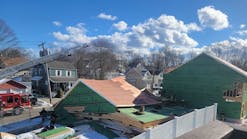- Slideshow Images: Houston FD HazMat Team
Houston is the fourth largest city in the United States, with a population of 1.9 million people and covering an area of 617 square miles. Houston is located in southeast Texas approximately 48 miles from the Gulf of Mexico. Houston is known as the "Petrochemical Capital of the World." It is reported that there is a greater concentration of chemical plants and refineries in Houston than anywhere else in the world. Most of the facilities are located along the shipping canal in Southeast Houston. Major fixed facility hazmat exposures include major oil companies Phillips and Shell tank storage, natural gas wells, an ammonia plant, the largest sulfuric recycle plant in the U.S., Houston Alkynes (acetylene), Liquid Air Products, NASA Johnson Space Center, medical centers and universities, and many small companies. Chemicals routinely found in the area include chlorine, LPG, ammonia, sulfuric acid, bleach, zinc and combustible metals. In addition to the shipping channel there are several major highways that criss-cross Houston including Interstates 610, 45, 10, and 59. Highway 225 is a major Texas highway that goes through Houston. Railroads entering Houston are the Union Pacific and a small local line.
The Houston Fire Department is an ISO Class 1 career department with an annual operating budget of $293 million boasting 3,470 plus uniformed personnel and 700 civilian employees led by Chief Phil Boriskie. Houston Fire operates 86 engine companies, 37 truck companies, 11 booster trucks (for small fires, brush, trash, etc.), 54 basic life support ambulances, 14 medic units, three hazmat units, two technical rescue units, three air cascades, a rehab truck, 11 aircraft crash units and miscellaneous vehicles. The fire department is organized into 21 districts with 89 fire stations and several new ones in various stages of construction and development. Houston personnel responded to over 326,000 alarms in 2004, including over 90,000 fires, with an average call volume of over 36,000 per month.
Houston, as with most cities in the United States, began with a volunteer fire department organized in1838. Volunteers protected Houston for 57 years when firefighters became paid in 1895.
Houston officially formed their hazardous materials team and placed it in service on October 5, 1979 and during 2004 celebrated 25 years of service. The team was equipped and trained for an initial outlay of $19,000. In 1983 the hazmat team became a stand alone dedicated team. The hazardous materials team responds to an average of 1,200 hazardous materials calls a year, not including local engine runs for hydrocarbon fuel spills and natural gas leaks. Engine companies carry 10 gallons of dispersant for use on small fuel spills. Any thing large is handled by the hazardous materials team. Houston Hazmat uses a liquid agent dispersant for hydrocarbon spills. Brush rigs have been outfitted with spray booms that apply that agent to the surface of the spill.
Vehicle(s)
Station 22 located at 7825 Harrisburg St. is a dedicated hazmat station. No other equipment is stationed there. Hazmat vehicles include two identically equipped hazmat response units, which are 1995 and 1996 Super Vac vehicles. Also located at Station 22 is Foam Engine 22 with a 2000 E-One with a 2000 gpm pump, 500-gallon water tank, 750-gallon foam tank, 1,000 feet of four-inch hose and a Williams Hot Shot II Foam System. Foam Engine 22 also carries decontamination equipment and can respond alone on some types of hazmat incidents. Also at Station 22 is a flatbed utility truck for carrying bulk foam and other equipment housed in a utility building behind Station 22.
Staffing
Houston's Hazmat personnel operate as a team with confidence in their abilities and in each other. Captains function like quarterbacks and not coaches. The Houston team is a dedicated team with 11 on-duty technicians per shift. Approximately 20 other technicians are assigned to other companies throughout the city but are not part of an organized response. All hazmat team members work a 24-hour on, 24-hour off, 24-hour on and five days off shift. The response area for the hazmat team is the entire City of Houston and Harris County. They have responded as far away as Austin County, Montgomery County and Galveston. Houston Hazmat relies heavily on the Channel Industries Mutual Aid Group (CIMA), an industrial organization, for backup during incidents. They also have mutual aid agreements with the newly formed Harris County Hazmat Team and the Ponderosa Volunteer Fire Department team. Assistance is also available from the Metropolitan Medical Strike Team (MMST) based in Houston.
Training Requirements
Training is conducted in house by hazmat team personnel and includes rules and regulations, personal protective equipment (PPE), plugging and diking, rail cars, tank trucks, decontamination, foam operations and chemistry. All firefighters in the department are trained to the awareness level.
Monitoring Instruments & Identification Equipment
Monitoring capabilities include:
- Four gas meters
- Mini RAEs
Terrorist Agent ID:
- Sol Mini-CAD
- Radiological Instruments
- APD 2000
Personnel Protective Equipment
Level A
- Kapplar Responder
Level B
- Kappler CPF 2 and 3 for Level B. They have both encapsulated and non-encapsulated Level B suits
Respiratory Protection
- Scott 4.5 SCBA with 60 minute bottles
Research Resources
Computer Software Programs
- CAMEO
- Internet Access
Hard Copy Reference Books
- ERG
- NIOSH
- Bureau of Explosives Book
- Condensed Chemical Dictionary
- Pesticide manual
- Various military books
Standard Operating Procedures/Guidelines
Check with Anchorage Fire Department Hazmat for specific SOP/SOG's
Major Hazmat Incidents
Houston has experienced numerous major hazardous materials incidents, before and since the hazmat team was formed. Anhydrous ammonia has been the source of several incidents. One emergency involved an anhydrous ammonia tanker truck on May 11, 1976. The MC 331 crashed through a guard rail and released ammonia on a freeway below. Many motorists were trapped in their cars by the ammonia vapors; seven died and 150 were injured. Several firefighters were also treated for ammonia inhalation.
Another ammonia incident occurred on Dec. 11, 1983, when the Borden's Ice Cream Plant experienced an explosion from leaking anhydrous ammonia used for cooling at the plant. There were no deaths or injuries. Several events delayed firefighters from entering the building before the explosion occurred that certainly would have caused firefighter injuries if not death.
One such delay occurred when firefighters outfitted the plant engineer with SCBA and provided impromptu training so he could enter with them and point out a leaking valve. The explosion occurred as they walked toward the building. Hazmat personnel had not yet arrived on scene when the explosion took place, and that may have saved them from injury and death as well.
At the time, there was a great deal of surprise among firefighters that ammonia would burn or explode. Previous procedures were to enter the building with chemical protection and stop the leaks. Following the Borden plant incident, procedures were changed to ventilate the building thoroughly before entering to plug leaks.
One of the largest fires to ever challenge the Houston Fire Department occurred on June 24, 1995. Seven alarms were transmitted for the Houston Distribution Warehouse complex located at 8550 Market St., starting with the first at 8:33 A.M. Two-thirds of the city's on-duty force was called on to fight the stubborn fire over the next 31 hours. Thirty-one engine companies and 14 ladder companies fought the fire. Warehouses in the complex were loaded with organic and inorganic chemicals, including corrosives, motor oils, plastics, solvents, cleaning compounds, lubricants, organophosphorus pesticides, flame retardants and metallic compounds.
Hazmat units responded on the second alarm. The fire overcame the building's sprinkler system and firefighter hose streams, and by 11 A.M. the building was totally involved. Exposures included five tractor-trailers loaded with organic peroxides and a liquefied petroleum gas rail car. Lines were placed in service to protect exposures and protective booms were placed to keep runoff water from entering storm drains. Mutual aid was requested from Channel Industries Mutual Aid (CIMA) at 7:30 P.M., which brought 10 foam tankers, four 2,000-gpm monitors mounted on trailers and a 6,700-gallon foam tanker to the scene.
After pouring foam on the fire all night, firefighters brought it under control at around 3 o'clock the following morning. Fire units remained on scene for several days putting out flair ups. Despite the magnitude of the fire and the chemicals involved, only three firefighters sustained minor injuries.
Contact Information:
For additional information or questions, contact: Captain Troy Lilley at 713-928-6711.
Slideshow Images:







